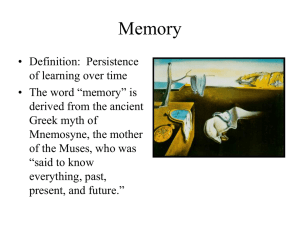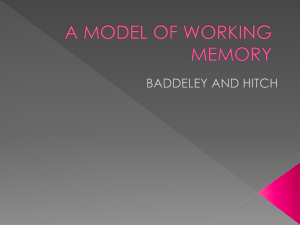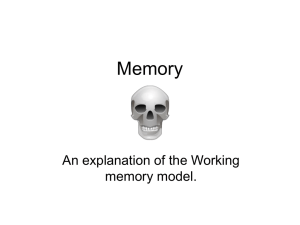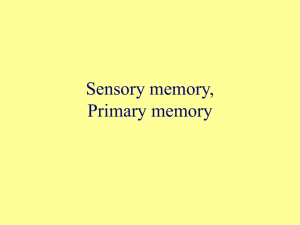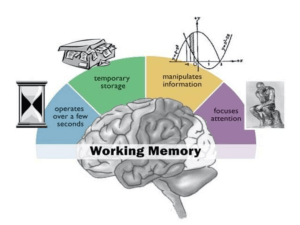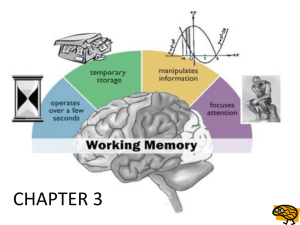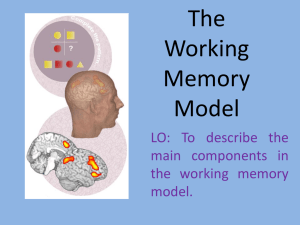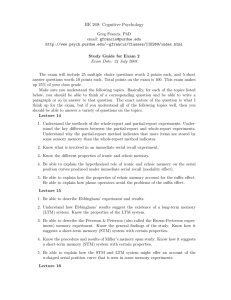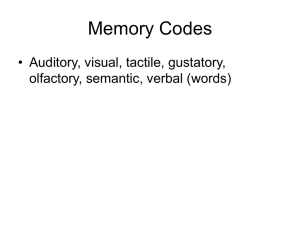Baddeley and Hitch (1974, 2000)
advertisement
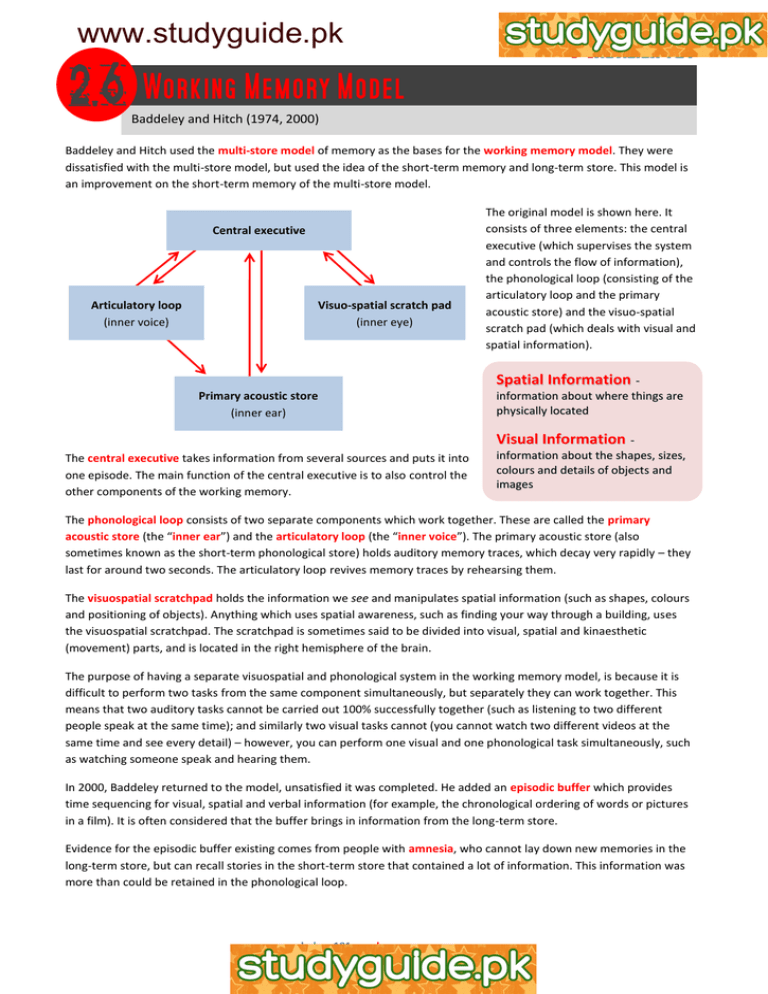
www.studyguide.pk Baddeley and Hitch (1974, 2000) Baddeley and Hitch used the multi-store model of memory as the bases for the working memory model. They were dissatisfied with the multi-store model, but used the idea of the short-term memory and long-term store. This model is an improvement on the short-term memory of the multi-store model. Central executive Articulatory loop (inner voice) Visuo-spatial scratch pad (inner eye) The original model is shown here. It consists of three elements: the central executive (which supervises the system and controls the flow of information), the phonological loop (consisting of the articulatory loop and the primary acoustic store) and the visuo-spatial scratch pad (which deals with visual and spatial information). Spatial Information Primary acoustic store (inner ear) information about where things are physically located Visual Information The central executive takes information from several sources and puts it into one episode. The main function of the central executive is to also control the other components of the working memory. information about the shapes, sizes, colours and details of objects and images The phonological loop consists of two separate components which work together. These are called the primary acoustic store (the “inner ear”) and the articulatory loop (the “inner voice”). The primary acoustic store (also sometimes known as the short-term phonological store) holds auditory memory traces, which decay very rapidly – they last for around two seconds. The articulatory loop revives memory traces by rehearsing them. The visuospatial scratchpad holds the information we see and manipulates spatial information (such as shapes, colours and positioning of objects). Anything which uses spatial awareness, such as finding your way through a building, uses the visuospatial scratchpad. The scratchpad is sometimes said to be divided into visual, spatial and kinaesthetic (movement) parts, and is located in the right hemisphere of the brain. The purpose of having a separate visuospatial and phonological system in the working memory model, is because it is difficult to perform two tasks from the same component simultaneously, but separately they can work together. This means that two auditory tasks cannot be carried out 100% successfully together (such as listening to two different people speak at the same time); and similarly two visual tasks cannot (you cannot watch two different videos at the same time and see every detail) – however, you can perform one visual and one phonological task simultaneously, such as watching someone speak and hearing them. In 2000, Baddeley returned to the model, unsatisfied it was completed. He added an episodic buffer which provides time sequencing for visual, spatial and verbal information (for example, the chronological ordering of words or pictures in a film). It is often considered that the buffer brings in information from the long-term store. Evidence for the episodic buffer existing comes from people with amnesia, who cannot lay down new memories in the long-term store, but can recall stories in the short-term store that contained a lot of information. This information was more than could be retained in the phonological loop. www.aspsychology101.wordpress.com www.studyguide.pk The diagram to the right shows the improved model of the working memory with the addition of the episodic buffer by Baddeley in 2000. The model remains as before in that it shows the visual and phonological systems are separated and that these two systems cannot have two similar tasks carried out together at the same time. A test which requires an individual to perform two tasks simultaneously is called a dualtask paradigm. Central executive Phonological loop Articulatory loop Episodic buffer Visuo-spatial scratch pad (inner eye) Primary acoustic store Language Episodic LTM Visual semantics EVIDENCE FOR THE WORKING MEMORY MODEL Evidence for the phonological loop is that word lists are better remembered when the words sound nothing alike than when they all sound the same. If participants are asked to learn a list of words, and at the same time, to say something aloud, then they will find learning difficult. This is said to be because they are already using the phonological loop. In this case, the articulatory loop (inner voice) is being used to say something aloud, and is therefore not available to rehearse the else information. Visual Cache one part of the visuospatial scratch pad which stores information about form and colour Inner Scribe one part of the visuospatial scratch pad which deals with spatial information and movement, but also rehearses all visuospatial information to be transferred to the central executive Evidence for the visuospatial scratchpad (separated into two parts: the visual cache, and the inner scribe) is that when someone tries to perform two spatial tasks simultaneously, it becomes difficult, but undertaking one visual task and one spatial task together is possible. Evidence which supports the idea that the inner scribe and visual cache are separated within the scratchpad is also present in the form of neurophysiological brain scans have shown that visual objects activate an area in the left hemisphere of the brain, and spatial tasks the right. Further evidence for the model as a whole, and that the visuospatial scratchpad and phonological loop are separate systems comes from patients who suffer from agnosia. This causes a loss of the ability to recognise objects (the visual cache), persons, sounds, shapes and even smells. This is often associated with brain injury or neurological illness. Sufferers will be unable to recognise an object they are presented with, but can still copy a drawing of that object (for example, if presented with a toy car, they cannot name it as a “car” but can look at it and draw it). This proves that the spatial component remains there and intact. EVALUATION OF THE MODEL Strengths The model is an expansion on the multi-store model, it shows why some dual tasks are different, and why you cannot undertake two different visual or verbal tasks simultaneously successfully There is much research supporting the model, including psychological lab experiments and neurophysiological research, such as brain scans showing the differences in brain activity Patients with agnosia support the model’s separation of visuospatial components www.aspsychology101.wordpress.com www.studyguide.pk De Groot (2006) looked at expert chess players, who were no better at recalling where chess pieces had been randomly placed on the chess board than non-players. However, when the pieces were placed in their correct positions, the chess players had a (predictably) outstanding memory of where they should be. This supports the idea of the long-term store being used to help interpret information in the working memory (short-term). Weaknesses Because the episodic buffer was added 26 years after the original model was published, it suggests that the original model was incomplete, therefore the model may not serve as an explanation of the working memory The model doesn’t account for all senses (it only relies on sound and sight), and much of the lab support for the model uses artificial tasks which lack validity: because the tasks are not true-to-life, you cannot guarantee that the other senses might have been used in real life www.aspsychology101.wordpress.com
